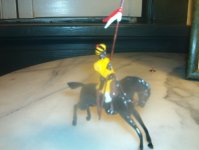At a certain point it's hard to tell if actual melding on a molecular level is going on or not, but I used it primarily as a filling material, and dragged out a very thin skin of solder for reinforcement, filing, then finishing with emery cloth (I did test the joints for strength). I didn't use the "approved" method of getting the solder to flow by heating the original material, so I suppose I would get a "cold" joint if it were an electronic connection (I used to be in the music business and had to solder stuff). I currently have the world's worst soldering iron but am saving up for a temperature controlled one. I've not had much success with the "approved method" for hollow cast lead-I'd guess it was because any difference in melting temperature was overridden by the tendency of the thinner original lead to absorb the heat more quickly and melt. The big thing I learned was to file the end of my soldering iron frequently down to the copper (I've read that the tips need to be replaced frequently, but who can afford that?). Thanks for all the praise lads- I'm still blushing! I think I just got lucky-my mum used to say, "Even a blind pig gets an acorn once in a while, Emily.". Cheers, Emily P.S. I'm working on a "Lancer turned in the saddle" who was missing his head from the shoulders up, so I'm having to build him a new neck (who can afford one in good condition?), so I haven't had a chance to post much-an it may put me in the looney bin, where I'll be found muttering, "Death or Glory, Death or Glory, Death or...".



